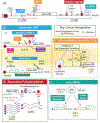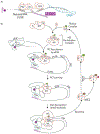The Untranslated Regions of mRNAs in Cancer
- PMID: 30961831
- PMCID: PMC6465068
- DOI: 10.1016/j.trecan.2019.02.011
The Untranslated Regions of mRNAs in Cancer
Abstract
The 5' and 3' untranslated regions (UTRs) regulate crucial aspects of post-transcriptional gene regulation that are necessary for the maintenance of cellular homeostasis. When these processes go awry through mutation or misexpression of certain regulatory elements, the subsequent deregulation of oncogenic gene expression can drive or enhance cancer pathogenesis. Although the number of known cancer-related mutations in UTR regulatory elements has recently increased markedly as a result of advances in whole-genome sequencing, little is known about how the majority of these genetic aberrations contribute functionally to disease. In this review we explore the regulatory functions of UTRs, how they are co-opted in cancer, new technologies to interrogate cancerous UTRs, and potential therapeutic opportunities stemming from these regions.
Keywords: 3′UTR; 5′UTR; RNA metabolism; cancer; mRNA translation; somatic mutation; therapy; untranslated region.
Copyright © 2019 Elsevier Inc. All rights reserved.
Figures


References
-
- Schwanhüusser B et al. (2011) Global quantification of mammalian gene expression control. Nature 473, 337–342 - PubMed
Publication types
MeSH terms
Substances
Grants and funding
LinkOut - more resources
Full Text Sources

